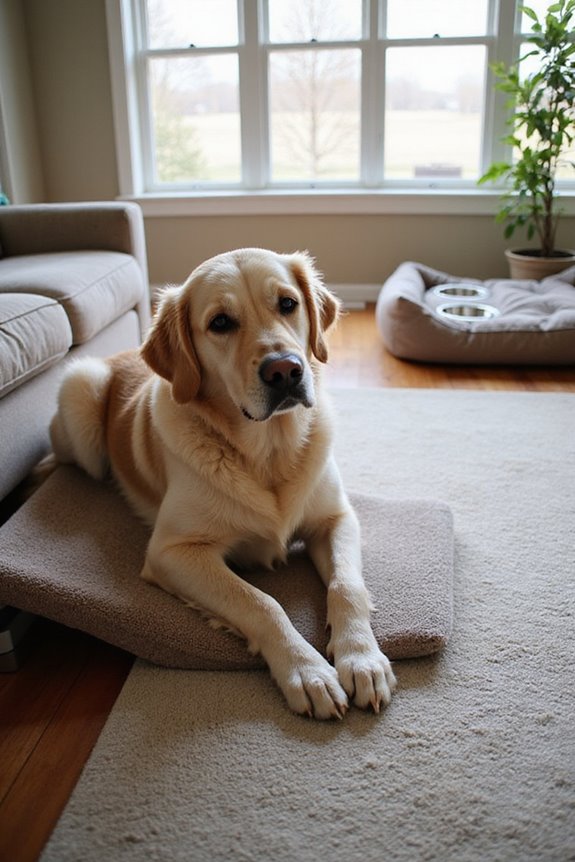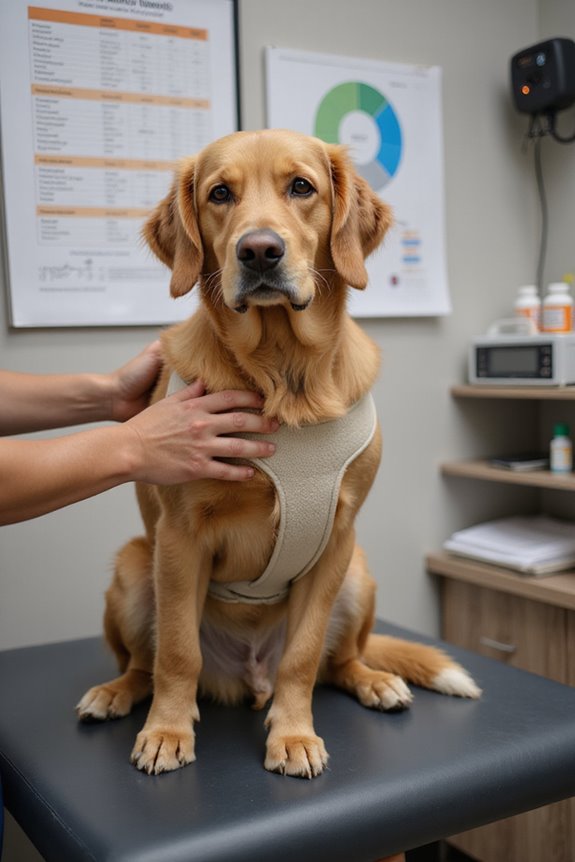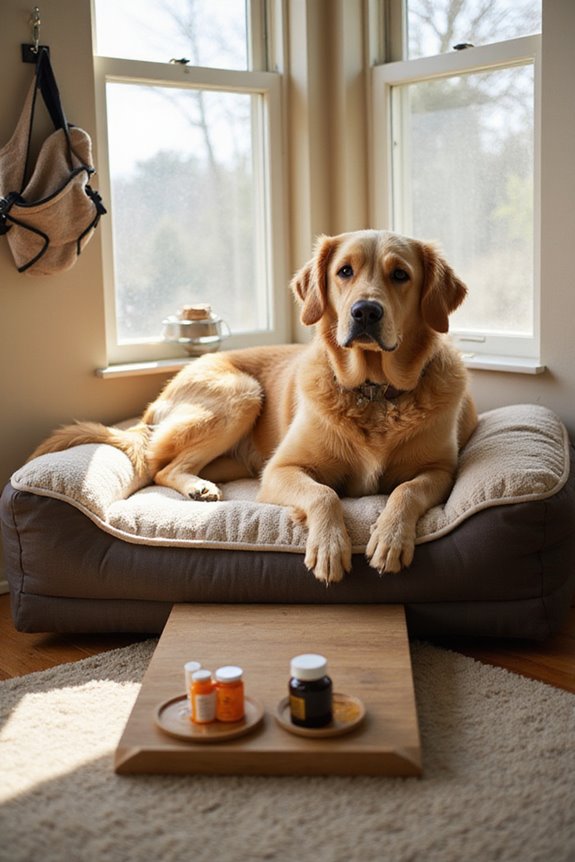To help your senior dog with mobility issues, first, recognize the signs of discomfort, such as limping or reluctance to move. Consider implementing a customized exercise program with short sessions focusing on gentle resistance and balance exercises. Environmental modifications, like nonslip mats and ramps, can enhance safety and comfort. Regular veterinary check-ups are essential for tailored care, while pain management strategies, including supplements and alternative therapies, can greatly improve mobility and well-being. Discover more effective strategies and tools for support.
Key Takeaways
- Monitor your dog’s behavior for signs of discomfort, such as reluctance to move or excessive licking of joints, to identify mobility issues early.
- Create a customized exercise program with short, gentle sessions focusing on strength, flexibility, and mobility, tailored to your dog’s specific needs.
- Schedule regular veterinary check-ups to evaluate joint health and receive recommendations for pain management and tailored exercise plans.
- Implement environmental modifications like nonslip mats and ramps to ensure safe navigation and reduce strain on your senior dog.
- Consider mobility aids such as harnesses and raised feeding bowls to support your dog’s movement and minimize discomfort while maintaining their quality of life.
Understanding Mobility Challenges in Senior Dogs
As dogs age, they inevitably encounter various mobility challenges that can hinder their quality of life. The aging process affects their canine anatomy, leading to conditions such as arthritis and hip dysplasia, which are common culprits behind joint pain and reduced mobility.
Key indicators of mobility challenges include:
- Reluctance to move or exercise
- Difficulty standing, climbing stairs, or jumping
- Limping or uneven weight distribution
- Excessive licking of joints
These signs often reflect underlying issues that can severely impact a dog’s comfort and independence. Recognizing these mobility challenges early is essential for effective intervention. Additionally, understanding the connection between aging and mobility can help in formulating strategies for better quality of life for our beloved companions. Incorporating dog arthritis supplements may significantly alleviate discomfort and enhance joint health.
Importance of Customized Exercise Programs

Customized exercise programs are essential for addressing the unique needs of senior dogs, especially when mobility issues arise. By focusing on individual capabilities, these programs can provide the right exercise variety to enhance strength, flexibility, and overall well-being.
- Program Flexibility: Adapt durations and types of activities based on each dog’s condition.
- Goals: Aim for improved joint mobility, body awareness, and balance while avoiding strain.
- Short Sessions: Keep sessions around 5 to 10 minutes, ensuring comfort and preventing fatigue.
- Activities: Incorporate gentle resistance training, mobility drills, and balance exercises tailored to their health status.
Through careful monitoring and gradual progression, we can support our senior dogs effectively, enhancing their quality of life while fostering their physical resilience and mental stimulation. Additionally, including joint health support in their diet can further aid in their mobility improvements.
Environmental Modifications for Comfort and Safety

Making environmental modifications can greatly enhance the comfort and safety of senior dogs dealing with mobility issues. Here are a few key adjustments you can make:
- Nonslip Surfaces: Install nonslip mats in frequently used areas, secure loose rugs, and consider rubberized flooring to provide better grip.
- Safe Pathways: Rearrange your furniture to create wide pathways free from clutter that could cause obstruction. Use ramps with gentle inclines to allow easy access to favorite spots.
- Bedding and Resting Areas: Opt for orthopedic beds that offer joint support and are placed in quiet, accessible locations. Additionally, consider heated dog beds with adjustable temperature settings to provide extra warmth and comfort for your senior pet.
Regular Veterinary Check-Ups and Medical Care

Even with the beneficial modifications made to create a safe and comfortable home environment, it’s imperative to focus on the medical oversight of senior dogs experiencing mobility issues. Regular veterinary check-ups can greatly impact your dog’s mobility. These exams focus on evaluating joint health, muscle mass, and neurological function. Here’s what to take into account:
- Veterinary Diagnostics: X-rays and MRIs can identify underlying conditions like arthritis or spinal issues.
- Mobility Evaluations: Regular assessments help differentiate normal aging from treatable ailments.
- Tailored Plans: Your vet will design exercise and weight management strategies to preserve and enhance mobility.
Additionally, incorporating joint supplements into their routine may provide added support for their mobility and overall comfort. Early detection leads to better outcomes, ensuring your furry friend has the best possible quality of life. Prioritizing these visits means you’re actively participating in their health management.
Effective Pain Management Strategies

When dealing with mobility issues in senior dogs, effective pain management strategies are essential for enhancing their quality of life. To start, pain relief supplements like omega-3 fatty acids can help reduce inflammation, while glucosamine and chondroitin may offer additional support. Always prioritize medication safety; consult your veterinarian before introducing any new medications or supplements, especially to avoid potential toxicity from human medications.
You might also consider using nonsteroidal anti-inflammatory drugs (NSAIDs) under veterinary guidance. These can greatly alleviate pain and improve mobility. Combining medications with alternative therapies, such as massage or hydrotherapy, can yield even better results. Additionally, incorporating probiotics for dogs can help support overall digestive health, which is important for maintaining a senior dog’s well-being. Remember, consistency and communication with your vet are key to tailoring the best pain management plan for your furry friend.
Maintaining a Healthy Lifestyle for Senior Dogs
As senior dogs grapple with mobility issues, maintaining a healthy lifestyle becomes a significant consideration alongside effective pain management. Prioritizing nutritional balance is essential; a diet rich in omega-3 fatty acids can help reduce inflammation and support joint health. Including joint supplements, such as glucosamine and chondroitin, can also promote cartilage repair, lessening stiffness. To support their physical well-being, I recommend regular, low-impact exercises, like 15-minute walks on flat terrain, which can enhance joint function without excessive strain. Additionally, adapting your home environment—such as adding non-slip mats and ramps—can minimize risks related to mobility. By focusing on these elements, we can foster a healthier, more comfortable life for our beloved senior dogs. Furthermore, incorporating senior dog multivitamins can provide comprehensive support for their overall health and well-being.
Supporting Mental and Cognitive Health
Supporting the mental and cognitive health of senior dogs is essential, particularly since cognitive decline can greatly affect their quality of life. To promote brain stimulation and cognitive enrichment, consider the following strategies:
- Antioxidants: Incorporate vitamins E and C into their diet to help combat cognitive decline.
- Interactive Toys: Utilize puzzles and treat-dispensing toys for mental engagement, rotating them frequently.
- Structured Routine: Establishing a consistent daily schedule reduces confusion and supports cognitive stability.
- Regular Exercise: Engage in daily walks and playtime to enhance both physical and mental well-being.
- Social Interaction: Play with other dogs or engage in interactive games like hide-and-seek to stimulate their minds.
These measures can markedly aid in preserving your senior dog’s cognitive function and overall happiness.
Recognizing Signs of Discomfort and Decline
Recognizing signs of discomfort and decline in senior dogs is essential for their overall well-being, particularly as they age and face mobility challenges. It’s important to observe both behavioral changes and physical symptoms that may indicate underlying issues. Look for:
- Gait Changes: Stiffness or limping can suggest pain or joint problems.
- Posture: Hunching or a preference for sitting on one side may signal discomfort.
- Activity Levels: Reluctance to go for walks or play can reflect fatigue or distress.
- Vocalizations: Groans or yelps during movement might indicate pain.
Being vigilant about these signs allows us to address discomfort and decline early, ensuring our senior dogs remain as comfortable and happy as possible during their golden years.
Utilizing Mobility Aids and Adaptive Tools
Mobility aids and adaptive tools are vital for enhancing the quality of life for senior dogs experiencing mobility issues, particularly when they struggle with everyday activities such as walking or climbing stairs. Consider various harness types, which provide support for walking or standing. Ramps and stairs can ease your dog’s access to furniture or vehicles while reducing strain on joints.
For more severe cases, wheelchair options are invaluable, allowing your dog to maintain mobility and exercise despite significant leg weakness. Additionally, incorporate raised food and water bowls to minimize bending. It’s important to monitor the fit and comfort of these aids regularly to prevent discomfort and guarantee your dog’s safety. With the right tools, you can greatly support their mobility and well-being.
Frequently Asked Questions
What Are Signs My Senior Dog Is in Pain?
I’ve noticed pain indicators in my senior dog, like decreased interest in activities and irritability. It breaks my heart to see signs of discomfort, like reluctance to be touched or difficulty getting up.
Can Diet Affect My Dog’s Mobility Issues?
I’ve noticed that my dog’s mobility really improves with a smart diet. Weight management and the right dietary supplements make a huge difference. It’s heartwarming to witness how these changes positively impact his daily life.
What Home Modifications Can Help My Dog?
I’ve found that ramp installation and adding non-slip surfaces really transformed my home for my dog. These small changes make a huge difference in helping them feel more secure and comfortable while moving around.
Are There Specific Exercises Safe for Arthritic Dogs?
I’ve found gentle stretches and water therapy really help my arthritic dog. Incorporating these into our routine has made a noticeable difference, allowing us to bond while keeping her comfortable and active. It’s truly heartwarming.
How Can I Encourage My Dog to Stay Active?
To keep my dog active, I’ve turned playtime into an adventure! Gentle activities like soft fetch and puzzle toys spark joy and engagement. Trust me, nothing beats the wag of a happy pup enjoying life!




